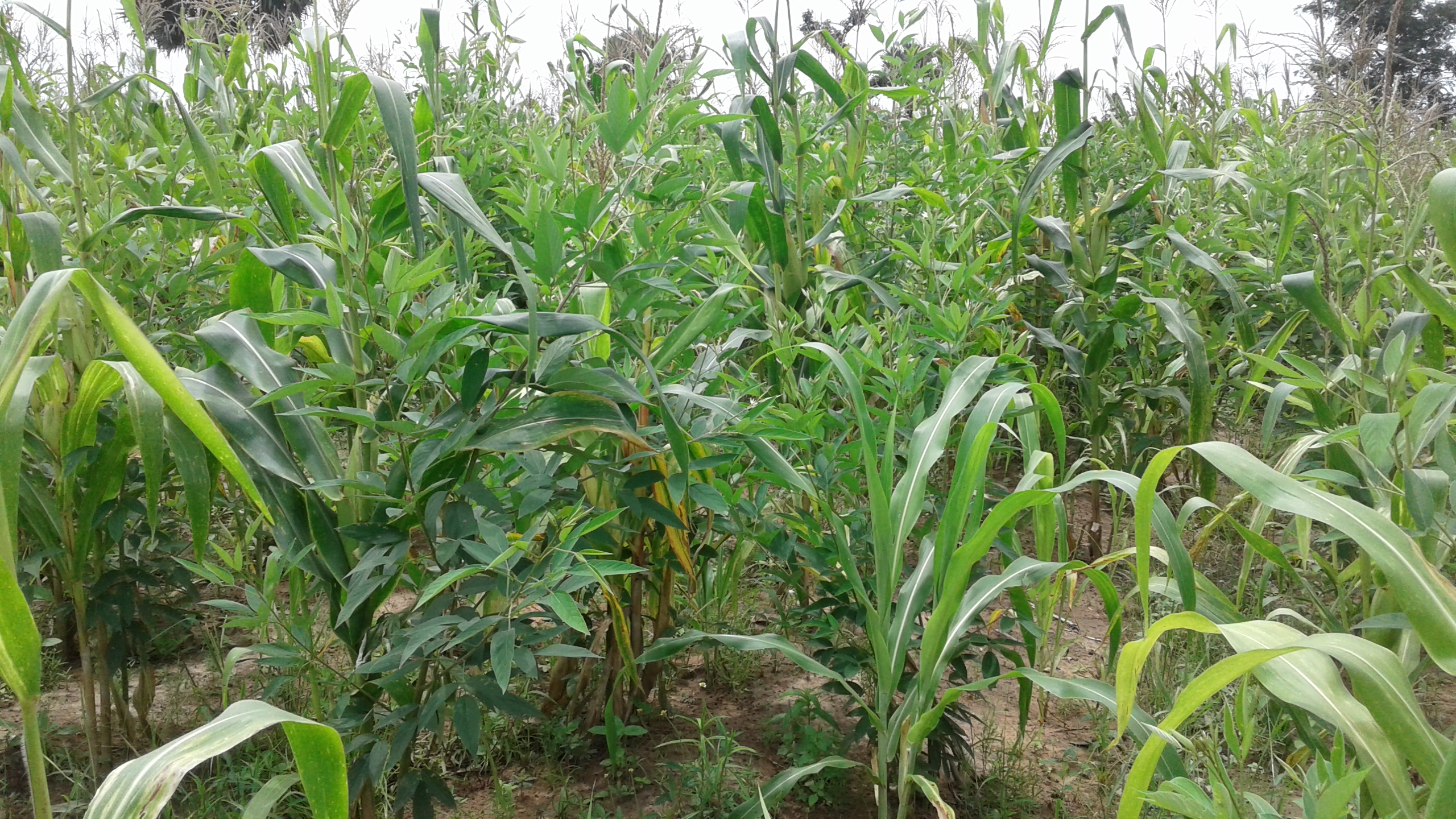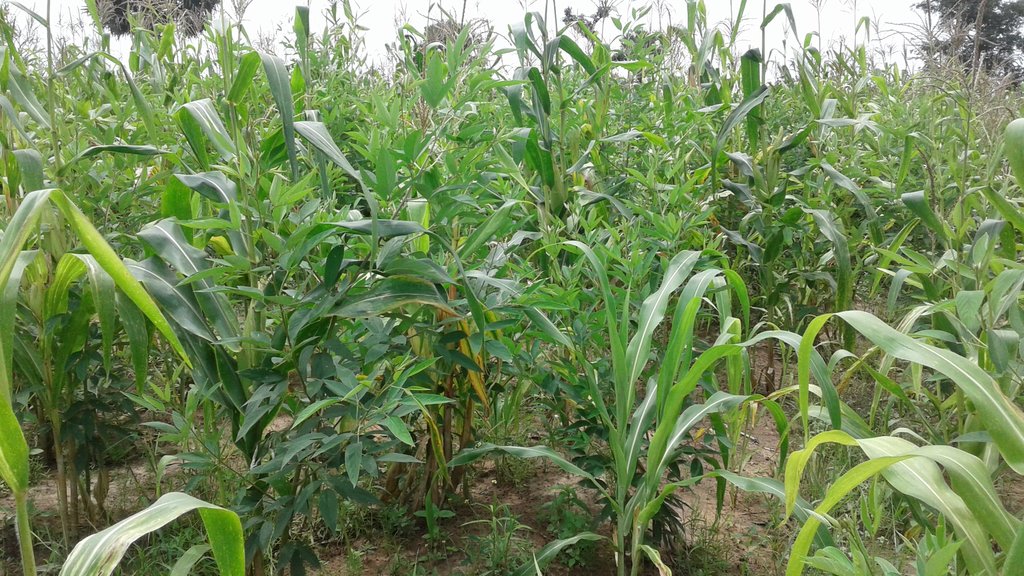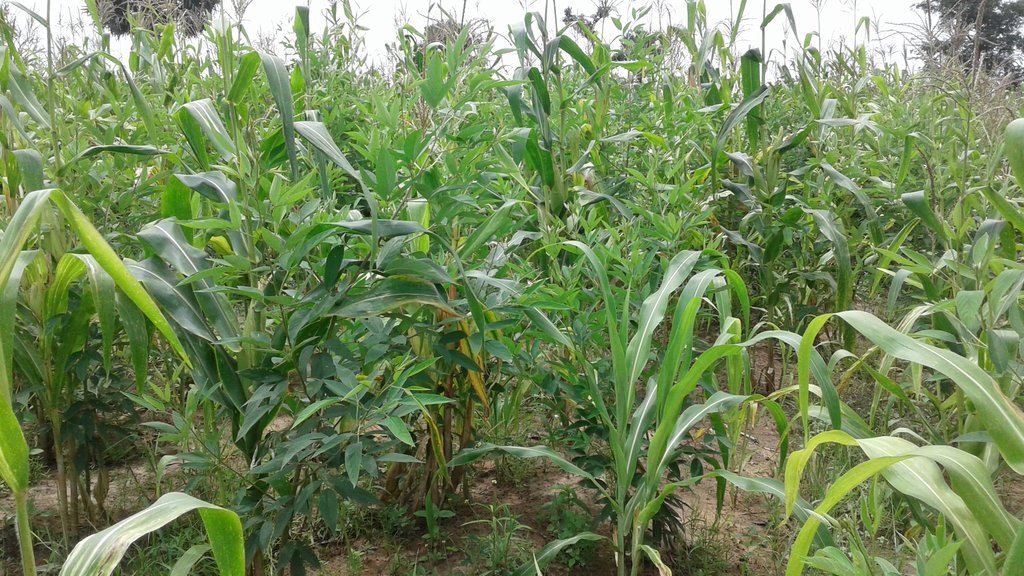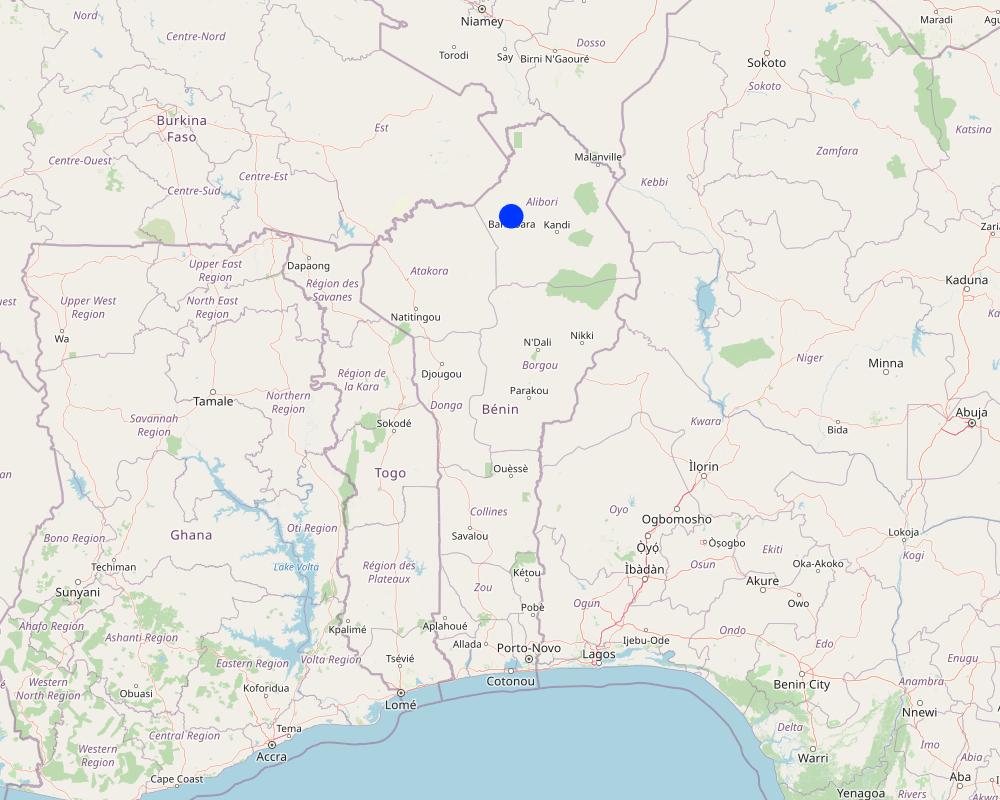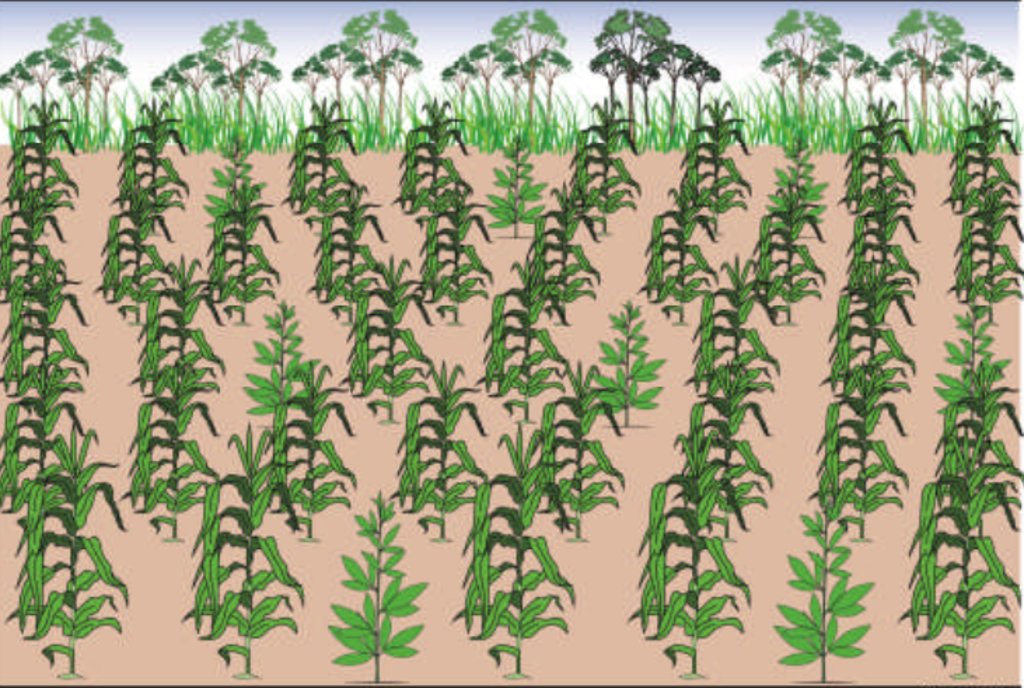Pois d'angole en association avec le maïs [Benin]
- Creation:
- Update:
- Compiler: Gatien AGBOKOUN CHRISTOPHE
- Editors: Siagbé Golli, Abdoul Karim MIEN, DOSSOU-YOVO bernardin
- Reviewer: Sally Bunning
Otri
technologies_6518 - Benin
View sections
Expand all Collapse all1. General information
1.2 Contact details of resource persons and institutions involved in the assessment and documentation of the Technology
Key resource person(s)
SLM specialist:
DOSSOUMON Roland
INUDE ONG
Benin
SLM specialist:
ALIOU Moumouni
INUDE ONG
Benin
Name of project which facilitated the documentation/ evaluation of the Technology (if relevant)
Soil protection and rehabilitation for food security (ProSo(i)l)Name of the institution(s) which facilitated the documentation/ evaluation of the Technology (if relevant)
Deutsche Gesellschaft für Internationale Zusammenarbeit (GIZ)1.3 Conditions regarding the use of data documented through WOCAT
The compiler and key resource person(s) accept the conditions regarding the use of data documented through WOCAT:
Yes
1.4 Declaration on sustainability of the described Technology
Is the Technology described here problematic with regard to land degradation, so that it cannot be declared a sustainable land management technology?
No
2. Description of the SLM Technology
2.1 Short description of the Technology
Definition of the Technology:
Le Pois d’Angole est une légumineuse arbustive connu pour ses possibilités dans l’amélioration physique et chimique des sols. Il peut fixer de manière symbiotique 70 kg d’azote par ha par saison jusqu'à la formation des gousses. En association avec le maïs, le pois d’Angole permet de doubler le rendement du maïs et la production de grains de pois d’angole qui est une bonne source de protéine. Cette technologie améliore le revenu des producteurs et contribue à la sécurité alimentaire.
2.2 Detailed description of the Technology
Description:
L'association du maïs et du pois d'Angole est appliquée sur une diversité de sols sauf sur sol hydromorphe.
Pour une association avec le maïs, les producteurs appliquent 20 kg/ha de semence de maïs pour 20kg de Pois d’Angole pour 2 graines par poquet . Les producteurs appliquent le semis en bande avec le maïs. Ils observent un écartement de 0,80 m sur la ligne et 1,60 m entre plants sur la ligne à une profondeur de 3 à 5 cm. Une ligne de maïs est mise en place entre deux lignes de pois d'Angole. En respectant cet écartement, on obtient une densité de 15625 à 25000 plants de pois d’Angole par hectare.
L'association du pois d'Angole au maïs est une des mesures d'adaptation au changement climatique. Sa mise en place a pour objectif de faciliter l’apport d’azote direct. Il s’agit donc en premier d’améliorer la productivité des sols à travers une amélioration de la fertilité, contribuant ainsi à garantir la sécurité alimentaire mais aussi protéger durablement le sol.
La mise en place et l’entretien passe par une succession d’opérations que sont la préparation de sol, l’achat des semences, le labour, le semis du maïs deux à 4 semaines avant le semis du pois d’angole. Ensuite suivent les opérations de sarclage et de sarclobuttage (au besoin). Les opérations de récolte démarrent par le maïs qui arrive à maturité avant le Pois d’Angole. Enfin viennent les opérations de battage. Les producteurs procèdent au recépage des plants de Pois d’Angole après la récolte mais aussi à l’installation de pare-feu dans le but d’assurer la pousse de nouvelles tiges florifères.
Associé au maïs, le pois d’angole permet de lutter contre les ravageurs du maïs, notamment les ravageurs de la feuille de maïs. Les feuilles des pois d’angole donnent assez de biomasse. Cette biomasse a pour avantage de non seulement faciliter la fertilisation du sol mais de limiter l’évapotranspiration du sol mais aussi de favoriser la vie microbienne.
Pour les producteurs, c'est une technologie simple et facile à mettre en œuvre. C'est une culture surnommée "trésor". Pour les producteurs, le contraste est net entre un champ où le maïs est associé au pois d’angole et là ça ne l’est pas. La raison est que les parcelle sans pois d’Angole (parcelle témoin) donnent généralement des rendements de 0,5 à 1t/ha de maïs contrairement aux parcelles avec pois d’Angole où ils ont pu obtenir des rendements allant jusqu’à 3t/ha de maïs.
2.3 Photos of the Technology
2.5 Country/ region/ locations where the Technology has been applied and which are covered by this assessment
Country:
Benin
Region/ State/ Province:
Alibori
Further specification of location:
Banikoara
Specify the spread of the Technology:
- evenly spread over an area
If the Technology is evenly spread over an area, specify area covered (in km2):
1.0
Is/are the technology site(s) located in a permanently protected area?
No
Map
×2.6 Date of implementation
Indicate year of implementation:
2016
2.7 Introduction of the Technology
Specify how the Technology was introduced:
- through projects/ external interventions
Comments (type of project, etc.):
Cette technologie a été introduite par le ProSOL de la GIZ Bénin
3. Classification of the SLM Technology
3.1 Main purpose(s) of the Technology
- improve production
- reduce, prevent, restore land degradation
- conserve ecosystem
- preserve/ improve biodiversity
- create beneficial economic impact
- create beneficial social impact
3.2 Current land use type(s) where the Technology is applied
Land use mixed within the same land unit:
No

Cropland
- Annual cropping
- Perennial (non-woody) cropping
Annual cropping - Specify crops:
- cereals - maize
- legumes and pulses - peas
Number of growing seasons per year:
- 1
Is intercropping practiced?
No
Is crop rotation practiced?
No
3.3 Has land use changed due to the implementation of the Technology?
Has land use changed due to the implementation of the Technology?
- Yes (Please fill out the questions below with regard to the land use before implementation of the Technology)
Land use mixed within the same land unit:
No

Cropland
- Annual cropping
- Perennial (non-woody) cropping
Annual cropping - Specify crops:
- cereals - maize
- Pois d'angole
Is intercropping practiced?
Yes
If yes, specify which crops are intercropped:
Le Pois d'angole est semé en culture intercalaire au maïs
Is crop rotation practiced?
No
3.4 Water supply
Water supply for the land on which the Technology is applied:
- rainfed
3.5 SLM group to which the Technology belongs
- improved ground/ vegetation cover
- integrated soil fertility management
3.6 SLM measures comprising the Technology

agronomic measures
- A1: Vegetation/ soil cover
- A2: Organic matter/ soil fertility
- A3: Soil surface treatment
- A6: Residue management
A3: Differentiate tillage systems:
A 3.1: No tillage
A6: Specify residue management:
A 6.4: retained

management measures
- M6: Waste management (recycling, re-use or reduce)
3.7 Main types of land degradation addressed by the Technology

chemical soil deterioration
- Cn: fertility decline and reduced organic matter content (not caused by erosion)

biological degradation
- Bh: loss of habitats
- Bq: quantity/ biomass decline
3.8 Prevention, reduction, or restoration of land degradation
Specify the goal of the Technology with regard to land degradation:
- reduce land degradation
- restore/ rehabilitate severely degraded land
4. Technical specifications, implementation activities, inputs, and costs
4.1 Technical drawing of the Technology
Technical specifications (related to technical drawing):
Semis du maïs :
Le maïs est semé à 40 cm sur les lignes et à 80 cm entre les lignes et à une profondeur de 3 à 5 cm à raison de 2 graines de maïs par poquet. Il faut prévoir 20 kg de semences de qualité pour 1 ha.
Semis du pois d’Angole
Le pois d’Angole (Cajanus cajan) est semé à 2 graines par poquet, deux semaines après le semis du maïs. L’écartement de semis est de 80 cm sur les lignes de maïs et de 160 cm entre les lignes (2 lignes de pois d’Angole séparées par 1 ligne de maïs) et à une profondeur de 3 à 5 cm. Il faut prévoir 20 kg de semences de qualité pour 1 ha.
Author:
Marcellin Allagbe et Adolphe Adjanohoun
Date:
11/03/2019
4.2 General information regarding the calculation of inputs and costs
Specify how costs and inputs were calculated:
- per Technology area
Indicate size and area unit:
1ha
other/ national currency (specify):
FCFA
If relevant, indicate exchange rate from USD to local currency (e.g. 1 USD = 79.9 Brazilian Real): 1 USD =:
615.0
Indicate average wage cost of hired labour per day:
2500
4.3 Establishment activities
| Activity | Timing (season) | |
|---|---|---|
| 1. | Défrichage | Mars - Avril |
| 2. | Labour | Mia à Juin |
| 3. | Semis du maïs | Juin - Juillet |
| 4. | Semis du pois d'Angole | Juin - Juillet |
| 5. | Sarclage | Juin et Juillet |
| 6. | Récolte du maïs | Décembre |
| 7. | Récolte du pois d'Angole | Janvier à Février |
4.4 Costs and inputs needed for establishment
| Specify input | Unit | Quantity | Costs per Unit | Total costs per input | % of costs borne by land users | |
|---|---|---|---|---|---|---|
| Labour | Défrichage | ha | 1.0 | 15000.0 | 15000.0 | 100.0 |
| Labour | Labour | ha | 1.0 | 30000.0 | 30000.0 | 100.0 |
| Labour | Semis du maïs | ha | 1.0 | 10000.0 | 10000.0 | 100.0 |
| Labour | Semis du pois d'angole | ha | 1.0 | 10000.0 | 10000.0 | 100.0 |
| Equipment | Sarclage | ha | 1.0 | 12000.0 | 12000.0 | 100.0 |
| Equipment | Récolte du maïs | ha | 1.0 | 15000.0 | 15000.0 | 100.0 |
| Equipment | Récolte du pois d'angole | ha | 1.0 | 10000.0 | 10000.0 | 100.0 |
| Plant material | Semences de maïs | Kg | 20.0 | 300.0 | 6000.0 | 100.0 |
| Plant material | Semences de pois d'angole | kg | 20.0 | 500.0 | 10000.0 | |
| Total costs for establishment of the Technology | 118000.0 | |||||
| Total costs for establishment of the Technology in USD | 191.87 | |||||
4.5 Maintenance/ recurrent activities
| Activity | Timing/ frequency | |
|---|---|---|
| 1. | Recépage | Janvier à Février |
| 2. | Installation de pare feu | Novembre à Décembre |
4.6 Costs and inputs needed for maintenance/ recurrent activities (per year)
| Specify input | Unit | Quantity | Costs per Unit | Total costs per input | % of costs borne by land users | |
|---|---|---|---|---|---|---|
| Labour | Recépage | ha | 1.0 | 10000.0 | 10000.0 | 100.0 |
| Labour | Installation de pare feu | ha | 1.0 | 5000.0 | 5000.0 | 100.0 |
| Total costs for maintenance of the Technology | 15000.0 | |||||
| Total costs for maintenance of the Technology in USD | 24.39 | |||||
4.7 Most important factors affecting the costs
Describe the most determinate factors affecting the costs:
Rareté de la main d'oeuvre
5. Natural and human environment
5.1 Climate
Annual rainfall
- < 250 mm
- 251-500 mm
- 501-750 mm
- 751-1,000 mm
- 1,001-1,500 mm
- 1,501-2,000 mm
- 2,001-3,000 mm
- 3,001-4,000 mm
- > 4,000 mm
Specify average annual rainfall (if known), in mm:
853.00
Agro-climatic zone
- semi-arid
5.2 Topography
Slopes on average:
- flat (0-2%)
- gentle (3-5%)
- moderate (6-10%)
- rolling (11-15%)
- hilly (16-30%)
- steep (31-60%)
- very steep (>60%)
Landforms:
- plateau/plains
- ridges
- mountain slopes
- hill slopes
- footslopes
- valley floors
Altitudinal zone:
- 0-100 m a.s.l.
- 101-500 m a.s.l.
- 501-1,000 m a.s.l.
- 1,001-1,500 m a.s.l.
- 1,501-2,000 m a.s.l.
- 2,001-2,500 m a.s.l.
- 2,501-3,000 m a.s.l.
- 3,001-4,000 m a.s.l.
- > 4,000 m a.s.l.
Indicate if the Technology is specifically applied in:
- not relevant
5.3 Soils
Soil depth on average:
- very shallow (0-20 cm)
- shallow (21-50 cm)
- moderately deep (51-80 cm)
- deep (81-120 cm)
- very deep (> 120 cm)
Soil texture (topsoil):
- medium (loamy, silty)
- fine/ heavy (clay)
Soil texture (> 20 cm below surface):
- medium (loamy, silty)
- fine/ heavy (clay)
Topsoil organic matter:
- low (<1%)
5.4 Water availability and quality
Ground water table:
5-50 m
Availability of surface water:
medium
Water quality (untreated):
poor drinking water (treatment required)
Water quality refers to:
ground water
Is water salinity a problem?
No
Is flooding of the area occurring?
Yes
Regularity:
episodically
5.5 Biodiversity
Species diversity:
- low
Habitat diversity:
- low
5.6 Characteristics of land users applying the Technology
Sedentary or nomadic:
- Sedentary
Market orientation of production system:
- mixed (subsistence/ commercial)
Off-farm income:
- less than 10% of all income
Relative level of wealth:
- poor
- average
Individuals or groups:
- groups/ community
Level of mechanization:
- animal traction
- mechanized/ motorized
Gender:
- women
- men
Age of land users:
- youth
- middle-aged
5.7 Average area of land used by land users applying the Technology
- < 0.5 ha
- 0.5-1 ha
- 1-2 ha
- 2-5 ha
- 5-15 ha
- 15-50 ha
- 50-100 ha
- 100-500 ha
- 500-1,000 ha
- 1,000-10,000 ha
- > 10,000 ha
Is this considered small-, medium- or large-scale (referring to local context)?
- small-scale
- medium-scale
5.8 Land ownership, land use rights, and water use rights
Land ownership:
- communal/ village
Land use rights:
- communal (organized)
Water use rights:
- communal (organized)
Are land use rights based on a traditional legal system?
Yes
Specify:
Le patriarche du clan fait la répartition de l'utilisation selon les enfants. Chaque enfant sait la zone qui lui ait dédiée
5.9 Access to services and infrastructure
health:
- poor
- moderate
- good
education:
- poor
- moderate
- good
technical assistance:
- poor
- moderate
- good
employment (e.g. off-farm):
- poor
- moderate
- good
markets:
- poor
- moderate
- good
energy:
- poor
- moderate
- good
roads and transport:
- poor
- moderate
- good
drinking water and sanitation:
- poor
- moderate
- good
financial services:
- poor
- moderate
- good
6. Impacts and concluding statements
6.1 On-site impacts the Technology has shown
Socio-economic impacts
Production
crop production
Quantity before SLM:
1,5t à l'hectare
Quantity after SLM:
2,5 tonne à l'hectare
Comments/ specify:
Une culture de maïs associée avec du pois d’Angole permet de doubler le rendement du maïs
crop quality
Comments/ specify:
Lorsque l'association se fait sur deux saisons, l'apport en engrais chimique n'est plus nécessaire. L'association faciliterait donc l'obtention de produits de bio
wood production
Comments/ specify:
Après le récépage, les tiges servent de bois de chauffage pour les femmes
product diversity
Comments/ specify:
Les graines de pois d'angole sont comestibles
land management
Income and costs
expenses on agricultural inputs
Comments/ specify:
Les feuilles des pois d’angole donnent assez de biomasse. Cette biomasse a pour avantage de faciliter la fertilisation du sol
farm income
Comments/ specify:
L'amélioration du rendement induit une amélioration des revenus agricoles
economic disparities
workload
Socio-cultural impacts
food security/ self-sufficiency
Comments/ specify:
L'amélioration du rendement du maïs et l'obtention des graines de pois d'angole contribuent à améliorer la sécurité alimentaire des producteurs
recreational opportunities
Comments/ specify:
En améliorant ses revenus le producteur a la possibilité de s'offrir plus de loisirs
SLM/ land degradation knowledge
Ecological impacts
Water cycle/ runoff
evaporation
Soil
soil organic matter/ below ground C
Climate and disaster risk reduction
micro-climate
6.2 Off-site impacts the Technology has shown
buffering/ filtering capacity
6.3 Exposure and sensitivity of the Technology to gradual climate change and climate-related extremes/ disasters (as perceived by land users)
Gradual climate change
Gradual climate change
| Season | increase or decrease | How does the Technology cope with it? | |
|---|---|---|---|
| annual temperature | increase | well | |
| seasonal temperature | dry season | decrease | moderately |
| annual rainfall | decrease | moderately | |
| seasonal rainfall | dry season | increase | well |
6.4 Cost-benefit analysis
How do the benefits compare with the establishment costs (from land users’ perspective)?
Short-term returns:
very positive
Long-term returns:
positive
How do the benefits compare with the maintenance/ recurrent costs (from land users' perspective)?
Short-term returns:
very positive
Long-term returns:
positive
6.5 Adoption of the Technology
- > 50%
Of all those who have adopted the Technology, how many did so spontaneously, i.e. without receiving any material incentives/ payments?
- 11-50%
6.6 Adaptation
Has the Technology been modified recently to adapt to changing conditions?
No
6.7 Strengths/ advantages/ opportunities of the Technology
| Strengths/ advantages/ opportunities in the land user’s view |
|---|
| Augmentation des rendements de cultures |
| Régénération de la fertilité des sols |
| Comestibilité des graines |
| Strengths/ advantages/ opportunities in the compiler’s or other key resource person’s view |
|---|
| Relèvement de la fertilité des sols |
| Grande capacité de fixation d'azote |
| Augmentation du rendement des cultures |
| Capacité de lutte contre les adventices |
6.8 Weaknesses/ disadvantages/ risks of the Technology and ways of overcoming them
| Weaknesses/ disadvantages/ risks in the land user’s view | How can they be overcome? |
|---|---|
| Difficultés d’entretien, éclatement brusque des gousses | Opérer l’entretien dès que les plants ne sont pas trop développées ; faire la récolte au fur et à mesures que les gousses prennent la couleur brune |
| Weaknesses/ disadvantages/ risks in the compiler’s or other key resource person’s view | How can they be overcome? |
|---|---|
| Quasi absence du marché pour l’écoulement des graines de pois d'angole | Créer des entrepôts pour la vente des graines de cette légumineuse ; exposition des graines du pois d’Angole lors des foires agricoles pour parler de ses bienfaits non seulement sur le plan environnemental mais aussi dans la santé et la sécuritaire alimentaire |
7. References and links
7.1 Methods/ sources of information
- field visits, field surveys
1
- interviews with land users
1
- interviews with SLM specialists/ experts
1
- compilation from reports and other existing documentation
4
When were the data compiled (in the field)?
21/01/2023
7.2 References to available publications
Title, author, year, ISBN:
Deutsche Gesellschaft für Internationale Zusammenarbeit (GIZ) GmbH, 2018, Compendium de fiches techniques du formateur
Title, author, year, ISBN:
INRAB, 2015, Fiche Technique pour l'association du maïs et du pois d'angole pour l'amélioration de la fertilité et de l'humidité du sol au Sud du Bénin
Available from where? Costs?
https://www.researchgate.net/publication/331862221_FICHE_TECHNIQUE_08
Title, author, year, ISBN:
AMADJI Firmin. 2004, Pour une amélioration durable de la fertilité du sol et des rendements au centre et au sud Bénin. Bulletin de la Recherche Agronomique du Bénin (BRAB), Annales des Sciences Agronomiques du Bénin. 2 (2): 123 -139
Title, author, year, ISBN:
BADOU A., AKONDE P. T., ADJANOHOUN A., ADJE I. T., AÏHOU K.et IGUE A. M. 2013, Effets de différents modes de gestion des résidus de soja sur le rendement du maïs dans les conditions agroécologiques du CentreBénin. Bulletin de la Recherche agronomique du Bénin (BRAB), Numéro spécial Fertilité du maïs – Janvier : 34-38. BRAB
Available from where? Costs?
http://www.slire.net
Links and modules
Expand all Collapse allLinks
No links
Modules
No modules


